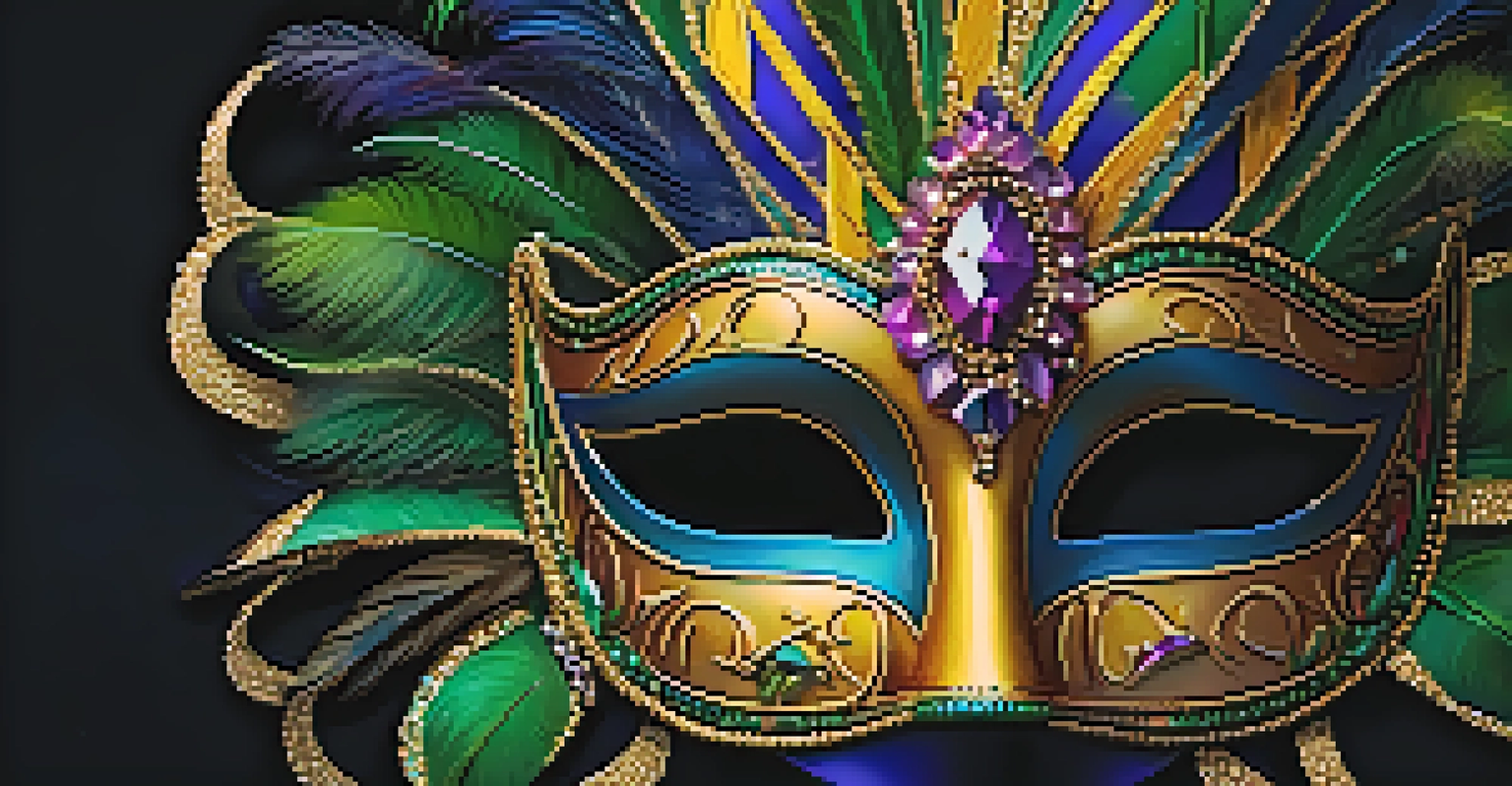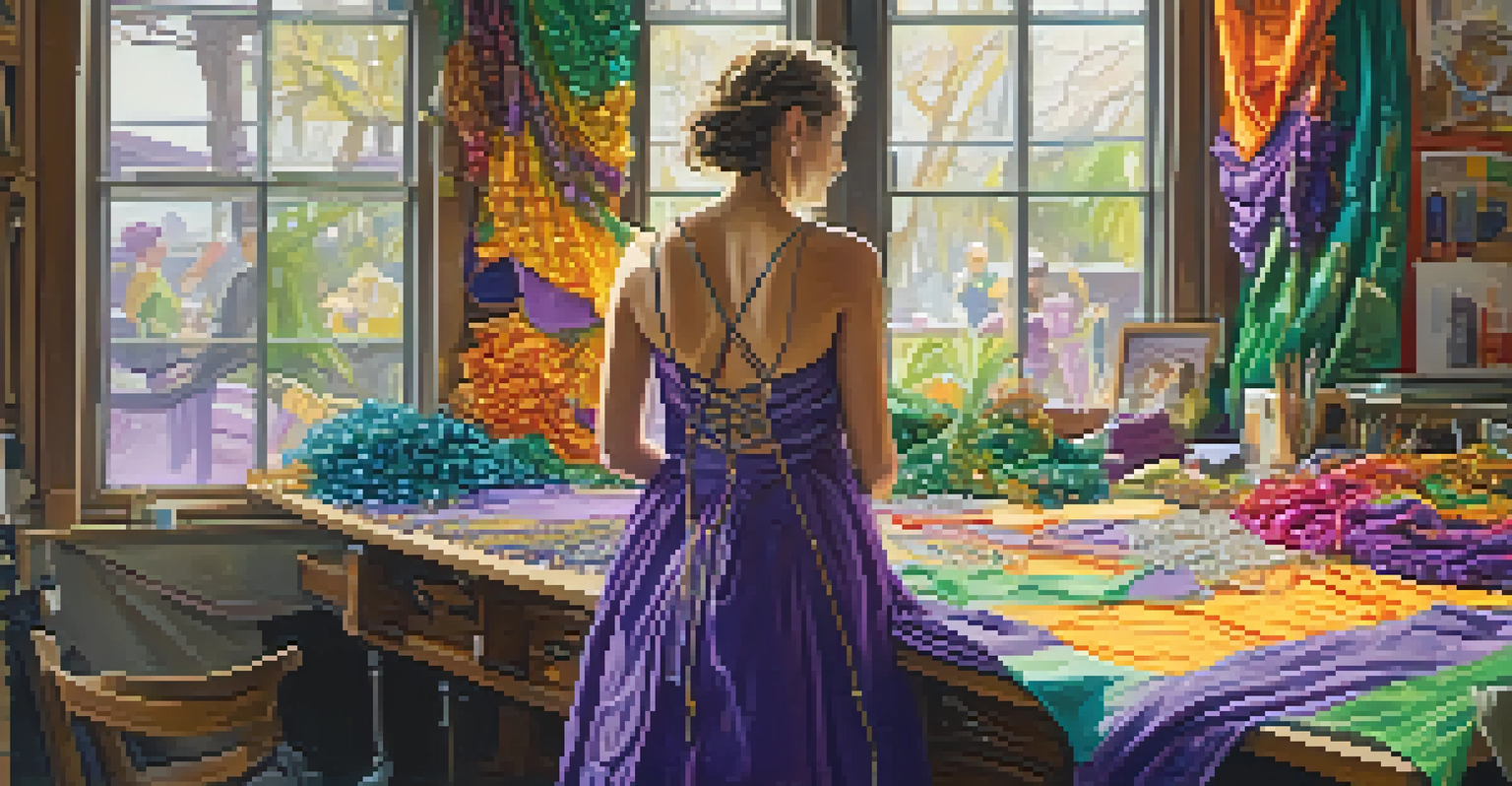The Art of Costumes: Mardi Gras Fashion and Symbolism

The Historical Roots of Mardi Gras Costumes
Mardi Gras, a celebration rich in history, has its roots in ancient traditions. The festival, which occurs before Lent, showcases a blend of different cultural influences, especially from French, Spanish, and African heritages. Costumes have evolved over centuries, reflecting the changing societal norms and artistic expressions of the times.
Costumes are a form of self-expression and a way to connect with our cultural roots.
Originally, costumes served practical purposes, often allowing participants to disguise their identities during festivities. This practice of masquerading not only offered anonymity but also encouraged a sense of community and freedom of expression. The flamboyant styles we see today are a testament to this historical evolution, combining tradition with modern flair.
Today, the costumes are an integral part of the Mardi Gras experience, representing a vibrant tapestry of creativity and cultural significance. From elaborate beaded gowns to playful jester outfits, each costume tells a story, inviting wearers and onlookers alike to partake in the joyous celebration.
Symbolism Behind Mardi Gras Colors
Mardi Gras is known for its iconic color scheme: purple, green, and gold. Each of these colors carries a specific meaning that enhances the overall symbolism of the festival. Purple represents justice, green symbolizes faith, and gold stands for power, creating a powerful visual statement that resonates with the spirit of the celebration.

These colors are not just for aesthetic appeal; they are deeply woven into the traditions and values of Mardi Gras. For instance, when participants don these colors, they are not merely dressing up; they are embodying the core principles of the festival itself. This connection fosters a sense of unity among revelers, as they collectively celebrate these ideals.
Mardi Gras Costumes Reflect Culture
Costumes embody the rich cultural heritage of Mardi Gras, showcasing influences from African, Spanish, and Creole traditions.
Moreover, the use of these colors can be seen in various elements of Mardi Gras, from beads to masks, amplifying their significance. The vibrant hues not only enhance the festive atmosphere but also serve as a reminder of the values that Mardi Gras represents, making every costume a part of a larger narrative.
The Role of Masks in Mardi Gras Tradition
Masks are a quintessential element of Mardi Gras, adding an air of mystery and intrigue to the festivities. They allow wearers to escape their everyday identities, encouraging boldness and creativity. Historically, masks have been used to conceal identities, thereby liberating participants from societal norms and expectations.
Mardi Gras is a time to celebrate life, creativity, and the beauty of community.
The artistry involved in mask-making is significant, showcasing the talents of local artisans. Each mask is unique, often adorned with intricate designs, feathers, and jewels, reflecting the personality or theme chosen by the wearer. This individuality is celebrated, as it adds to the overall vibrancy of the celebration.
Wearing a mask also fosters a sense of community among participants, as it creates a shared experience of anonymity and freedom. As revelers dance and mingle, the masks become symbols of unity amidst diversity, with each mask telling a different story within the rich tapestry of Mardi Gras culture.
The Influence of Cultural Heritage on Costumes
Mardi Gras costumes are a beautiful reflection of the diverse cultural heritage that converges during the celebration. Many costumes draw inspiration from African, Spanish, and Creole traditions, showcasing the rich history of New Orleans. This blending of cultures is not just visually stunning but also enriches the narrative of Mardi Gras.
Costumes often incorporate traditional elements, such as African prints or Spanish lace, creating a dialogue between the past and present. This fusion allows for a celebration of cultural identity and pride, giving participants a chance to honor their roots while participating in a collective celebration. It’s a reminder of the shared history that shapes the festival.
Symbolic Colors Enhance Unity
The iconic colors of purple, green, and gold symbolize justice, faith, and power, fostering a sense of unity among participants.
Furthermore, the storytelling aspect of these costumes fosters an appreciation for the unique contributions of various cultures. Each outfit serves as a canvas, showcasing the artistry and creativity of its maker, while also inviting others to learn about and appreciate the rich tapestry of traditions that come together during Mardi Gras.
The Craft of Costume Design for Mardi Gras
Costume design for Mardi Gras is an art form that requires creativity, skill, and a deep understanding of the festival's spirit. Designers often spend months crafting their pieces, ensuring that every detail aligns with the colorful and vibrant atmosphere of the celebration. From choosing fabrics to selecting embellishments, each decision is crucial to the final look.
The design process not only involves artistic vision but also practical considerations, such as comfort and mobility. Revelers often participate in parades and dance, so costumes must be functional as well as stunning. This balance between aesthetics and practicality is what makes Mardi Gras costumes truly exceptional.
Additionally, the collaborative nature of costume design fosters a sense of community among creators. Many designers work with local artisans and craftspeople, reinforcing the community-oriented spirit of Mardi Gras. This collaboration not only enhances the quality of the costumes but also strengthens the bonds within the local arts community.
The Evolution of Mardi Gras Fashion
Mardi Gras fashion has undergone significant transformation over the years, reflecting broader societal changes and trends. What began as simple disguises evolved into elaborate costumes that celebrate creativity and self-expression. Each decade brings its own flair, influenced by fashion trends, pop culture, and social movements.
In recent years, there’s been a shift towards sustainability in costume design, with many participants opting for eco-friendly materials and practices. This evolution highlights a growing awareness of environmental issues and a desire to celebrate Mardi Gras in a way that is respectful to the planet. It’s a modern twist on a long-standing tradition.
Masks Foster Anonymity and Freedom
Masks add mystery to Mardi Gras, allowing wearers to escape societal norms and encouraging creativity and community among revelers.
Moreover, social media has played a transformative role in how Mardi Gras fashion is showcased and shared. Platforms like Instagram and TikTok allow participants to share their costumes with a global audience, inspiring creativity and setting new trends. This interconnectedness enhances the festival's reach and impact, drawing more people into the vibrant world of Mardi Gras.
Conclusion: The Significance of Mardi Gras Costumes
In conclusion, Mardi Gras costumes are much more than mere garments; they embody the spirit of celebration, creativity, and community. Each costume reflects a rich tapestry of history, culture, and personal expression, inviting everyone to partake in the festivities. The vibrant colors and intricate designs tell stories that connect individuals to the larger narrative of Mardi Gras.
As participants don their costumes each year, they embrace the freedom and joy that comes with the celebration. The act of dressing up becomes a ritual that fosters connection, encouraging people to celebrate not just their individuality but also their shared experiences. It’s a beautiful reminder that we are all part of something bigger.

Ultimately, the art of Mardi Gras costumes encapsulates the essence of the festival: a joyful expression of life, culture, and creativity. As the parades roll through the streets and the music fills the air, these costumes become symbols of unity and celebration, making Mardi Gras a truly unforgettable experience.